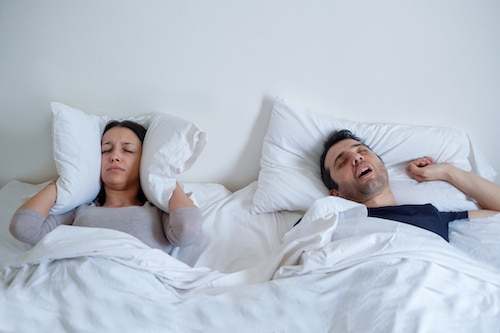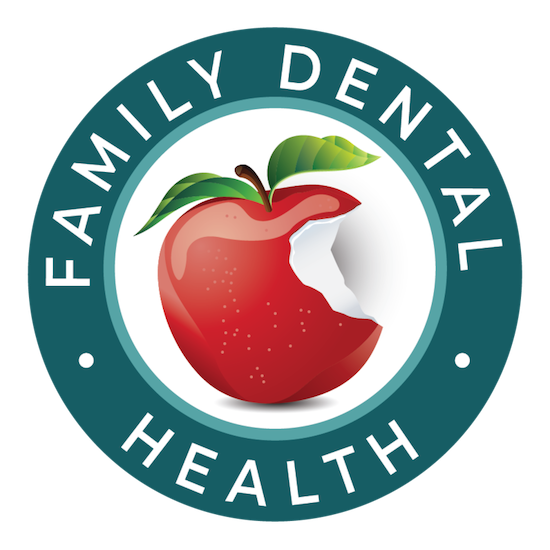Sleep apnea is one of the most prevalent sleep disorders, with around 100 million people suffering from it worldwide. Obstructive sleep apnea tends to affect men more than women, and is most common in smokers and people who are significantly overweight or obese.
 If you suspect that you or a loved one is suffering from sleep apnea, call Flatrock Family Dentistry today at (864) 297-5268 to schedule your consultation. Our dentists are highly experienced in diagnosing and treating sleep apnea.
If you suspect that you or a loved one is suffering from sleep apnea, call Flatrock Family Dentistry today at (864) 297-5268 to schedule your consultation. Our dentists are highly experienced in diagnosing and treating sleep apnea.
Causes of Sleep Apnea
Obstructive sleep apnea is generally caused by an obstruction in the airway when sleeping. While you sleep, your soft tissues can collapse into your airway, obstructing your breath and causing you to wake up multiple times in the night. Risk factors for developing obstructive sleep apnea include:
- Obesity
- Smoking
- Heavy drinking
- Having a narrow airway or thick neck
- Family history
Adults and children alike can develop sleep apnea, although it is most common in people middle aged or older. Sleep apnea can also affect both men and women, although it is more common in men.
Symptoms of Sleep Apnea
Sleep apnea can cause a variety of physical and mental symptoms, including:
- Snoring
- Daytime fatigue
- Irritability
- Concentration problems
- Waking up with dry mouth
Loud snoring is one of the most recognisable symptoms of sleep apnea, and is a reason why many people discover their sleep apnea through a partner. If your partner is often woken up by loud, incessant snoring, it could be a sign of sleep apnea.
Since people with sleep apnea wake up multiple times in the night, even if they don’t realize that they’re waking up, they often develop symptoms associated with lack of sleep or poor quality sleep. Fatigue, concentration issues, memory problems, irritability, and more can all be signs that you’re not getting good quality sleep and may have sleep apnea.
What Happens if You Leave Your Sleep Apnea Untreated?
 It is important to manage sleep apnea. The disorder has been linked to:
It is important to manage sleep apnea. The disorder has been linked to:
- Heart attack
- Heart failure
- High blood pressure
- Stroke
- Diabetes
- Stress
- Depression
- Increased risk of motor vehicle accidents
- Poor performance at work
- Strained relationships
Several studies have shown a connection between sleep apnea and cardiovascular and metabolic diseases. A certain percentage of sleep apnea sufferers are also obese or overweight, which may in part explain the increased prevelance of heart and metabolic issues among this group. Losing weight is often a good option for both alleviating sleep apnea and reducing a person’s risk of developing these health problems. It’s also possible that the stress of sleep apnea contributes to these health problems.
Is There Anything I Can Do to Naturally Help My Sleep Apnea?
Lifestyle changes in combination with oral appliance therapy is often an effective means of controlling sleep apnea. You will need to work with your doctor to discuss how to address your sleep condition by natural means, or lifestyle changes.
Your doctor may recommend:
- Weight loss, if you are overweight
- Quitting all tobacco products, if you smoke or otherwise use tobacco
- Reducing or eliminating alcohol consumption
- Taking steps to reduce stress in your life
While our dentists may have some recommendations for coping with sleep apnea, we will handle the custom oral appliance portion of your treatment and advise you to consult your doctor about other aspects.
Sleep Apnea Treatment Options
The most common treatment for sleep apnea is a CPAP (continuous positive airway pressure) machine. However, many people have trouble adjusting to wearing a CPAP and end up not using it every night. CPAP machines are loud, can be uncomfortable, and are difficult to travel with, which can be dealbreakers for many people.
How Long Can It Take to Get Used to a CPAP Machine?
The mask, tubing, and air pressure of a CPAP mask takes some getting used to. In fact, 30-90 days would be considered a perfectly normal amount of time to adjust to wearing the device while you sleep. Some people never get used to it and find they can’t get a good night’s rest. A custom oral appliance from our dentists may be the right alternative for mild to moderate sleep apnea.
If you can get used to a CPAP machine and use it every night, it’s typically considered the best sleep apnea treatment. However, if you can’t get used to it or if your sleep apnea is on the mild or moderate end of the spectrum, you may benefit from an oral appliance.
Are There Any Alternatives to Treat Sleep Apnea?
The main alternative to a CPAP machine is a custom oral appliance, provided you are a good candidate for this alternative. While a CPAP blows constant air into your airway to keep it open, the oral appliance keeps the airway clear by holding the jaws and tongue in a forward position, so they don’t collapse and block your air.
An oral appliance fits over your teeth, similar to the way an Invisalign aligner or a nighttime teeth grinding guard fits over your teeth. They are relatively comfortable to wear and easy to take with you when you travel.
Does a Sleep Test Need to be Performed in Order to Get Treatment for Sleep Apnea?
You will most likely need some type of sleep test to confirm your doctor’s diagnosis of sleep apnea. The typical patient experience is to receive a prescription for CPAP or an oral appliance. The prescription comes from their doctor after they have received an exam. As part of this process, your doctor may order a sleep test to confirm the diagnosis. There are several types of tests, some of which can be completed at home. Patients visit our dentists to discuss oral appliance therapy after their diagnosis.
Oral appliances have a number of benefits over a CPAP machine, including:
- Quiet
- Easy to wear
- Easy to travel with
- Doesn’t disturb your partner
- Much smaller than a CPAP machine
We can fit you with a custom oral appliance for sleep apnea that is as comfortable and effective as possible.
Does Sleep Apnea Always Cause Snoring?
People confuse sleep apnea with snoring. Snoring involves a disturbance or impediment to the airflow. Snoring occurs when there is resistance to airflow when a person is sleeping, particularly when lying on his or her back. The noise results from the tissues in the back of the throat vibrating against one another when the person inhales.
When a person has sleep apnea, the airflow is partially or completely blocked, and the person stops breathing for a period of a few seconds or even a minute. While snorers can have sleep apnea, it is not a direct causal link. Virtually all people with sleep apnea will snore, however.
How Do I Know if I Have Sleep Apnea?
Sleep apnea has two sets of symptoms: those that occur at night and those that occur the following day. You may not have any idea that you are having problems at night with your sleeping, but the daytime symptoms can provide a clue. These are the common symptoms of sleep apnea:
- Awakening with shortness of breath
- Episodes of breathing cessation witnessed by another person
- Loud snoring
- Abrupt awakenings from sleep, often with snorting sounds
- Waking up with a headache in the morning
- Excessive daytime sleepiness
- Waking up with a dry mouth or sore throat
- Difficulty staying asleep
- Attention problems
- Irritability
If Dr. Khan suspect you may have sleep apnea, the next step would be a bed partner survey and an Eppworth questionnaire, followed by an at-home sleep study.
How Long Are the Breathing Pauses in Sleep Apnea?
Most pauses in breathing last for 10 to 20 seconds, but they can last longer in more extreme cases. These brief pauses can happen as many as 30 times per hour over the night.
To contact Flatrock Family Dentistry to schedule a consultation, click here!
Are There Habits or Things I’m Doing that Exacerbate My Sleep Apnea?
Anatomy predisposes many people to being at risk for developing sleep apnea, but there are other things you can be doing that elevate your risk. Some things you can control; others you cannot.
- Anatomy — The most important cause of sleep apnea is the structure of your airway. Your nose, tonsils, palate, tongue, and jaw position all play a role. These are genetic factors; however, you can influence them by maintaining a healthy weight.
- Sleep position — For many people, the way they sleep directly affects their sleep apnea. A sleep study could reveal that sleeping on your back, in the supine position, leads to increased breathing disruption. This occurs because the soft tissues of the airway, including the soft palate and tongue, can fall back and block the passage of air. Sleeping on your side can be helpful for these patients.
- Smoking — Cigarette smoking increases the risk and severity of sleep apnea. It inflames tissues and increases mucus congestion in the upper airway. It also tends to disrupt a person’s sleep patterns.
- Alcohol — Alcohol consumption negatively affects sleep. Although it may initially make you sleepy, as the alcohol wears off it leads to sleep fragmentation and insomnia. In addition, and more important to sleep apnea, alcohol acts as a muscle relaxer, and this can make the tissues in the upper airway more collapsible. A good rule of thumb is this — allow one hour to elapse for each alcoholic beverage you consume before going to bed.
- Menopause — The hormones progesterone and estrogen help maintain firmness in the tissues at the back of the airway. When women lose those hormones due to menopause, their incidence of sleep apnea rises.
- Medications — Three classes of medications can be problematic: benzodiazepines, opiates, and barbiturates. Benzodiazepines are often prescribed for anxiety, seizures, and were previously used for insomnia. They also work as muscle relaxants and can affect the airway.
Opiates are narcotics used to control pain. They contribute to central sleep apnea (the kind that originates in brain messages) by creating shallow or irregular breathing. Barbiturates have similar impacts and likewise affect breathing.
- Weight gain — Being obese or overweight will increase the fatty tissues at the back of the airway and can lead to more obstruction. With weight gain, fat accumulates at the base of the tongue and along the airway, making the passage narrower.
How Long Does It Take to Correct Sleep Apnea?
Once a person develops sleep apnea, treatment is often an ongoing thing. This is true if the factors behind the sleep apnea are issues such as anatomy or aging tissues that are simply not as firm. Oral appliance therapy or CPAP will usually be long-term treatments in these cases.
However, if there are personal factors behind your sleep apnea, such as being overweight, these can obviously be changed, and your sleep apnea may resolve. Changing or removing medications could have instant affect. So could limiting your alcohol before bed. Even sleep position.
How Is Sleep Apnea Treated?
At Flatrock Family Dentistry, we start with conservative treatment options and progress from there. Lifestyle changes, such as losing weight, limiting alcohol consumption, or quitting smoking — those types of changes are the first treatment steps. From there, the next options are breathing systems such as CPAP or oral appliance therapy. Severe cases may require surgery as the patient is in danger of developing serious medical conditions such as high blood pressure and heart problems.
What is CPAP?
The most popular treatment for obstructive sleep apnea is called continuous positive airway pressure (CPAP). This is a breathing system that uses air pressure to keep the upper airway passages open. The patient wears a mask over his or her nose during sleep. The mask delivers air pressure that is somewhat greater than the air pressure in the bedroom. This difference in pressure keeps the airway passages open, preventing snoring and apnea.
What Is Oral Appliance Therapy?
Oral appliance therapy uses what is akin to a sports mouth guard or an orthodontic retainer. Worn only during sleep, the oral appliance supports the jaw in a forward position to help maintain an open upper airway. At Flatrock Family Dentistry, we have dozens of different options for custom-made appliances. They are custom made to fit your bite and can be worn comfortably for the long haul.
What Negative Effects Can Sleep Apnea Have on The Body?
We have patients who discount the seriousness of sleep apnea, thinking it’s just a little snoring. That’s a risky line of thinking. Untreated sleep apnea can lead to a number of very serious health concerns:
- High blood pressure — Because you wake up over and over during the night, this process places stress on your body, activating your hormone systems. This raises your blood pressure.
- Heart disease — People with obstructive sleep apnea are more likely to have heart attacks, strokes, and atrial fibrillation.
- Type 2 diabetes — Sleep apnea is common in people with type 2 diabetes. This is because when your body is tired it has trouble effectively processing insulin.
- Weight gain — Sleep apnea can make your body release more of the hormone ghrelin, which makes you crave carbs and sweets.
- Adult asthma — Adult asthma and sleep apnea combined tend to cause the patient to suffer from more asthma attacks.
- Car accidents — People with sleep apnea are up to five times more likely than normal sleepers to have traffic accidents, and to even fall asleep at the wheel.
Schedule Your Sleep Apnea Consultation
If you think you may be suffering from sleep apnea, call Flatrock Family Dentistry today at (864) 297-5268 to schedule your consultation today.
Take-Home Sleep Study
Our dentists are pleased to work with your physician, a board-certified sleep physician, and your medical insurance to provide proper diagnosis and treatment for sleep-related disorders like sleep apnea. As part of our services, we provide take-home sleep studies. At Flatrock Family Dentistry, we use the NOX-T3 System to help identify sleep-related dental concerns.
The NOX-T3 is a portable sleep monitor that uses Bluetooth technology to create a wireless body area network, which helps to maximize your comfort. The system features built-in microphone that records high-quality sound, giving us the ability to play the audio along with other recorded signals from your sleep study. This gives Dr. Khan new insights into sleep medicine and your unique situation.
Using the NOX-T3 system requires only a few quick steps. If you have any problems while getting the system set up before bed, here is brief outline of the steps we discussed in our office:
- Fasten the NOX device to the shirt.
- Attach the thorax belt to the device.
- Attach the abdomen cable to the device.
- Attach the abdomen belt to the abdomen cable.
- Hook up the oximeter around your wrist.
- Put on the nasal cannula.
Flatrock Family Dentistry Sleep Study Tutorial

